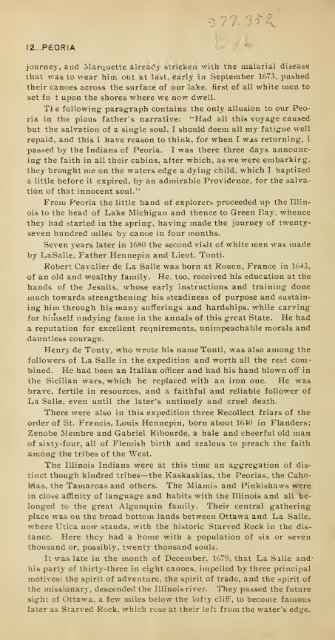A brief history of Peoria - University Library
A brief history of Peoria - University Library
A brief history of Peoria - University Library
Create successful ePaper yourself
Turn your PDF publications into a flip-book with our unique Google optimized e-Paper software.
12. ..PEORIA<br />
g77,3^^<br />
journey, and Marquette already' stricken with the malarial disease<br />
that was to wear him out at last, early in September 1673, pushed<br />
their canoes across the surface <strong>of</strong> our lake, first <strong>of</strong> all white men to<br />
set fo t upon the shores where we now dwell.<br />
Tl, e following paragraph contains the only allusion to our <strong>Peoria</strong><br />
in the pious father's narrative: "Had all this voyage caused<br />
but the salvation <strong>of</strong> a single soul, I should deem all my fatigue well<br />
repaid, and this I have reason to think, for when I was returning, I<br />
passed by the Indians <strong>of</strong> <strong>Peoria</strong>. I was there three days announcing<br />
the faith in all their cabins, after which, as we were embarkicg,<br />
they brought me on the waters edge a dying child, which I baptized<br />
a little before it expired, by an admirable Providence, for the salva-<br />
tion <strong>of</strong> that innocent soul."<br />
From <strong>Peoria</strong> the little band <strong>of</strong> explorers proceeded up the Illinois<br />
to the head <strong>of</strong> Lake Michigan and thence to Green Bay, whence<br />
Ihey had started in the spring, having made the journey <strong>of</strong> twentyseven<br />
hundred miles by canoe in four months.<br />
Seven years later in 1680 the second visit <strong>of</strong> white men was made<br />
"by IvaSalle, Father Hennepin and Lieut. Tonti.<br />
Robert Cavalier de La Salle was born at Rouen, France in 1643,<br />
<strong>of</strong> an old and wealthy family. He, too, received his education at the<br />
hands <strong>of</strong> the Jesuits, whose early instructions and training done<br />
much towards strengthening his steadiness <strong>of</strong> purpose and sustaining<br />
him through his many sufferings and hardships, while carving<br />
for himself undying fame in the annals <strong>of</strong> this great State. He had<br />
a reputation for excellent requirements, unimpeachable morals and<br />
dauntless courage.<br />
Henry de Tonty, who wrote his name Tonti, was also among the<br />
followers <strong>of</strong> La Salle in the expedition and worth all the rest combined.<br />
He had been an Italian <strong>of</strong>ficer and had his hand blown <strong>of</strong>f in<br />
the Sicilian wars, which he replaced with an iron one. He was<br />
brave, fertile in resources, and a faithful and reliable follower <strong>of</strong><br />
La Salle, even until the later's untimely and cruel death.<br />
There were also in this expedition three Recollect friars <strong>of</strong> the<br />
order <strong>of</strong> St. Francis, Louis Hennepin, born about 1640 in Flanders;<br />
Zenobe Membre and Gabriel Ribourde, a hale and cheerful old man<br />
<strong>of</strong> sixt3--four, all <strong>of</strong> Flemish birth and zealous to preach the faith<br />
among the tribes <strong>of</strong> the West.<br />
The Illinois Indians were at this time an aggregation <strong>of</strong> distinct<br />
though kindred tribes— the Kaskaskias, the <strong>Peoria</strong>s, the Cahokias,<br />
the Tamaroas and others. The Miamis and Pinkishaws were<br />
in close affinity <strong>of</strong> language and habits with the Illinois and all belonged<br />
to the great Algonquin family. Their central gathering<br />
place was on the broad bottom lands between Ottawa and La Salle,<br />
where Utica now stands, with the historic Starved Rock in the distance.<br />
Here they had a home with a population <strong>of</strong> six or seven<br />
thousand or, possibly, twenty thousand souls.<br />
It was late in the month <strong>of</strong> December, 1679, that La SiUe and-<br />
his party <strong>of</strong> thirty-three in eight canoes, impelled by three principal<br />
motives: the spirit <strong>of</strong> adventure, the spirit <strong>of</strong> trade, and the spirit <strong>of</strong><br />
the missionary, descended the Illinois river. They passed the future<br />
sight <strong>of</strong> Ottawa, a few miles below the l<strong>of</strong>ty cliff, to become famous<br />
later as Starved Rock, which rose at their left from the water's edge.










![Novellen [microform] - University Library](https://img.yumpu.com/21939450/1/171x260/novellen-microform-university-library.jpg?quality=85)
![Anecdota Chisiana de re metrica [microform]](https://img.yumpu.com/21939448/1/190x239/anecdota-chisiana-de-re-metrica-microform.jpg?quality=85)



![Schollenbruch [microform] : Gedichte - University Library](https://img.yumpu.com/21939437/1/174x260/schollenbruch-microform-gedichte-university-library.jpg?quality=85)

